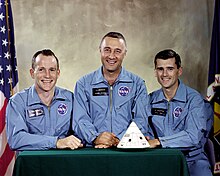
Back Apollo 1 Afrikaans أبولو 1 Arabic Apollon 1 Azerbaijani Аполо 1 Bulgarian অ্যাপোলো ১ Bengali/Bangla Apollo 1 Catalan Apollo 1 Czech Apollo 1 Danish Apollo 1 German Απόλλων 1 Greek
 Gus Grissom, Ed White, and Roger B. Chaffee in front of the launch pad containing their AS-204 space vehicle | |
| Names | AS-204, Apollo 1 |
|---|---|
| Mission type | Crewed spacecraft verification test |
| Operator | NASA |
| Mission duration | Up to 14 days (planned) |
| Spacecraft properties | |
| Spacecraft | CSM-012 |
| Spacecraft type | Apollo command and service module, Block I |
| Manufacturer | North American Aviation |
| Launch mass | 20,000 kilograms (45,000 lb) |
| Crew | |
| Crew size | 3 |
| Members | |
| Start of mission | |
| Launch date | February 21, 1967 (planned) |
| Rocket | Saturn IB AS-204 |
| Launch site | Cape Kennedy LC-34 |
| End of mission | |
| Destroyed |
|
| Orbital parameters | |
| Reference system | Geocentric |
| Regime | Low Earth orbit |
| Perigee altitude | 220 kilometers (120 nmi) (planned) |
| Apogee altitude | 300 kilometers (160 nmi) (planned) |
| Inclination | 31 degrees (planned) |
| Period | 89.7 minutes (planned) |

 From left: White, Grissom, Chaffee | |
Apollo 1, initially designated AS-204, was planned to be the first crewed mission of the Apollo program,[1] the American undertaking to land the first man on the Moon. It was planned to launch on February 21, 1967, as the first low Earth orbital test of the Apollo command and service module. The mission never flew; a cabin fire during a launch rehearsal test at Cape Kennedy Air Force Station Launch Complex 34 on January 27 killed all three crew members—Command Pilot Gus Grissom, Senior Pilot Ed White, and Pilot Roger B. Chaffee—and destroyed the command module (CM). The name Apollo 1, chosen by the crew, was made official by NASA in their honor after the fire.
Immediately after the fire, NASA convened an Accident Review Board to determine the cause of the fire, and both chambers of the United States Congress conducted their own committee inquiries to oversee NASA's investigation. The ignition source of the fire was determined to be electrical, and the fire spread rapidly due to combustible nylon material and the high-pressure pure oxygen cabin atmosphere. Rescue was prevented by the plug door hatch, which could not be opened against the internal pressure of the cabin. Because the rocket was unfueled, the test had not been considered hazardous, and emergency preparedness for it was poor.
During the Congressional investigation, Senator Walter Mondale publicly revealed a NASA internal document citing problems with prime Apollo contractor North American Aviation, which became known as the Phillips Report. This disclosure embarrassed NASA Administrator James E. Webb, who was unaware of the document's existence, and attracted controversy to the Apollo program. Despite congressional displeasure at NASA's lack of openness, both congressional committees ruled that the issues raised in the report had no bearing on the accident.
Crewed Apollo flights were suspended for twenty months while the command module's hazards were addressed. However, the development and uncrewed testing of the lunar module (LM) and Saturn V rocket continued. The Saturn IB launch vehicle for Apollo 1, AS-204, was used for the first LM test flight, Apollo 5. The first successful crewed Apollo mission was flown by Apollo 1's backup crew on Apollo 7 in October 1968.